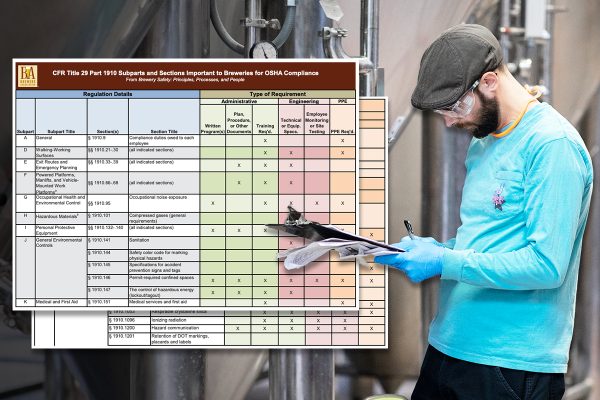Do you have the posting deadline for your OSHA 300A in your calendar? February 1, right?
Maybe it slipped your mind. Perhaps you are new to the business. The Brewers Association Safety Subcommittee would like to remind all breweries employing greater than 10 full-time equivalent workers of the obligation to document all recordable work-related injuries or illnesses.
A “recordable work-related injury or illness,” according to OSHA, involves “death, loss of consciousness, days away from work, restriction of work or motion, transfer to another job, medical treatment other than first aid, or diagnosis of a significant injury or illness by a physician or other licensed health care professional.”
For example, a minor sprain that is treated on-site using ice, an athletic wrap and ibuprofen does not require recording. A back strain from improper lifting of malt sacks that results in a CAT scan and physical therapy is recordable. Minor burn from contact with a steam pipe: not recordable. Kettle boil over causing third degree burns and requiring hospitalization and skin grafting: recordable.
Beyond counting how many recordables occur during the year, OSHA wants employers to tally the number of days of work affected by those injuries and illnesses. This measurement is called DART – the Days Away from work, days of Restricted work, and days of work Transferred to another activity.
OSHA has three one-page forms for this requirement. They are not difficult to complete if you understand what each one is for. They print best on 8.5 x 14 inch paper.
Here’s a handy table explaining each. We have listed the forms in the order you should be filling them out — which is not the numerical order of the forms — one of OSHA’s little quirks.
| Form No. | Form Title | What is It and When is It Required? |
|---|---|---|
| 301 | Injury and Illness Incident Report | A confidential medical information form that is completed within 7 calendar days after you receive information that a recordable work-related injury or illness has occurred. The 301 records the personal information of the injured worker, a listing of medical professionals who consulted, and incident details of the particular injury or illness. 301 records must be kept for a minimum of five years. |
| 300 | Log of Work-Related Injuries and Illnesses | This form is essentially a registry of all Injury and Illness Incident Reports (301 forms) filed throughout the calendar year. This form includes confidential information, including the worker’s identity, a description of the incident and the resulting injury or illness, and a place to indicate the DART days and classification of injury or illness type. The 300 form is completed even when there are no recordable work-related injuries or illnesses. |
| 300A | Summary of Work-Related Injuries and Illnesses | The public summary form that draws from the 300 form entries. It does not list worker names, but tallies the number of cases and total DART days. Importantly, the 300A includes a signed affidavit from a company executive. The 300A for the previous calendar year must be posted visibly in the workplace from February 1 through April 30. The 300A is posted even when there are no recordable work-related injuries or illnesses. |
The most important form right now is the 300A. It is due to be posted February 1. All three forms are available in fillable .pdf and .xls formats at https://www.osha.gov/recordkeeping/forms.
A concise slide show by OSHA provides excellent advice and can be found here: https://www.osha.gov/recordkeeping/osha-Log300-11-01.ppt.
Failure to record injuries and illnesses is a common OSHA citation during inspections. Without accurate injury data, a company cannot reliably know if improvements in workplace safety have resulted in reduced injury rates. Zero injury experiences are just as important as those reporting injuries to keep annual record keeping data accurate and compliant.
BA Safety Ambassador Matt Stinchfield can be contacted with specific questions at safetyambassador@brewersassociation.org.








